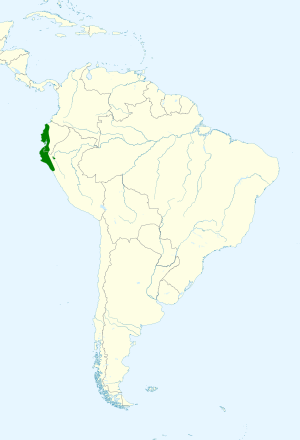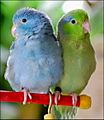Pacific parrotlet facts for kids
Quick facts for kids Pacific parrotlet |
|
|---|---|
 |
|
| in Ecuador | |
| Conservation status | |
| Scientific classification | |
| Genus: |
Forpus
|
| Species: |
coelestis
|
 |
|
The Pacific parrotlet (Forpus coelestis) is a small parrot. It is also known as Lesson's parrotlet or the celestial parrotlet. These tiny birds belong to the Psittacidae family.
Contents
About the Pacific Parrotlet
The Pacific parrotlet (Forpus coelestis) is a small green parrot. It comes from South America. These birds are usually about 11–14 centimetres (4.3–5.5 in) long. They typically weigh 30 grams or more.
Wild Pacific parrotlets are mostly green. They have a soft grey color on their bodies. Their faces are bright green, and their beaks are pinkish. Their legs and feet are also pinkish-grey.
Male and Female Differences
Male and female Pacific parrotlets look different. This is called sexual dimorphism.
- Males have blue colors on their wings. This blue can be bright or very light. They also have blue streaks behind their eyes, which looks like "eyeshadow." Males have blue on their lower backs, called the rump.
- Females do not have blue on their wings. They can sometimes have blue eye streaks and a blue rump, just like males.
Personality and Behavior
Parrotlets are sometimes called "pocket parrots" because they are so small. But they have big personalities! They are known for being feisty and curious.
If kept as pets, parrotlets are usually kept alone. This is because they can be aggressive towards other birds. They might fight or even hurt other birds if kept in a small space. It's best not to keep them with other types of birds.
Colors and Mutations
The natural color of parrotlets is green. But breeders have created many different colors. These are called "mutations." Some of these colors include:
- Yellow
- Blue
- White
- Turquoise
- Grey
- Albino (all white with red eyes)
- Lutino (all yellow with red eyes)
- Cinnamon
- Misty
- Pied (patches of different colors)
Where Pacific Parrotlets Live
Wild Pacific parrotlets live in western Ecuador and northwestern Peru. They are most common in dry places. These include deserts and forests where trees lose their leaves. But they have also moved into wetter areas where forests have been cut down.
They are found in large groups, called flocks, of 40 to 50 birds. They live in woodlands, clearings with shrubs, gardens, parks, and farmlands. They prefer subtropical or tropical dry forests, subtropical or tropical moist lowland forests, and dry shrublands.
Pacific parrotlets do not migrate. This means they stay in the same area all year long.
Conservation Status
The Pacific parrotlet is listed as "Least Concern" by the IUCN Red List. This means they are not currently in danger of disappearing. The number of these birds in the wild seems to be stable.
Pacific Parrotlet Behavior
Social Life
Pacific parrotlets live in flocks of 40 to 50 birds in the wild. Their calls are high-pitched and fast. When many birds call at once, it sounds like constant chattering.
In captivity, it's often best to keep them as a pair in a large cage. They are very social birds and need a friend of their own kind. However, they can be very aggressive towards other birds. The cage must be big enough so that if one bird gets upset, the other can fly away.
If you want to introduce two parrotlets, do it slowly. First, keep them in separate cages in the same room. After a while, let them spend supervised time together outside their cages. Once they become friends, you can move them into one large cage. It's best if neither bird has lived in the large cage before. This helps prevent them from being territorial.
Reproduction and Life Cycle
Pacific parrotlets are very protective of their eggs and babies. A female usually lays 4 to 6 white eggs. The eggs hatch after about 18 days.
In the wild, they build nests in holes in trees or on fence posts. They have also been seen nesting in old nests of other birds, like necklaced spinetails.
What Pacific Parrotlets Eat
In the wild, Pacific parrotlets eat berries and cactus fruits. They are not very picky eaters.
As pets, parrotlets need a varied diet. They can eat many fruits, seeds, vegetables, and herbs. Some good foods include:
- Quinoa
- Millet
- Broccoli
- Beetroot
- Oats
- Bell pepper
- Brown rice
- Apples
- Pomegranate seeds
You can also mix these foods together into a "chop." This can be blended and frozen for later use.
Baby parrotlets need a special hand-feeding formula. They need help eating until they are about a month old. Older birds will start to eat more seeds or pellets. Fresh fruits and vegetables should always be given along with their main diet.
Pacific Parrotlets as Pets
Pacific parrotlets are not very common in pet stores. They are valued by bird breeders. Their price can range from $250 to $1200.
In the wild, Pacific parrotlets usually live for about 10 years. But pet parrotlets can live much longer, up to 25 years! This happens with good care, proper breeding, and regular visits to the vet.
Like many larger parrots, Pacific parrotlets can learn to "speak." They can mimic words and phrases. Their voices are not as clear as bigger birds, and their vocabulary is usually small. But they can still learn a few words!
These birds are well known among owners for being feisty and curious. This is true even though they are so small.
See also
 In Spanish: Cotorrita celestial para niños
In Spanish: Cotorrita celestial para niños









